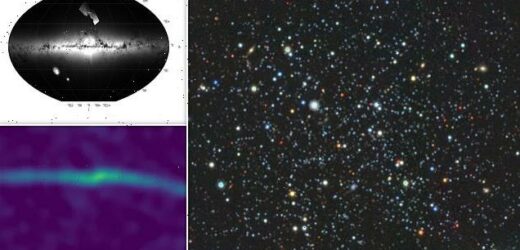‘Supra-massive’ population of more than 100 black holes is discovered orbiting our own galaxy – each with a mass of about 20 times that of the Sun, study finds
- The ‘gang’ of black holes site inside the ancient globular cluster called Palomar 5
- It is a 10-billion-year-old collection of stars that orbits around the Milky Way
- The globular cluster sits about 80,000 light years from the Earth with a star trail
- This trail of stars stretch outwards from the cluster for up to 13,000 light years
- Palomar 5 contains about three times as many blackholes as astronomers would expect to find in a star cluster of this size, say the University of Barcelona team
A cluster of more than 100 black holes has been discovered orbiting the Milky Way by astronomers, who say they each has a mass 20 times that of the sun.
The dense stellar objects sit inside Palomar 5, a 10-billion-year-old collection of stars that orbits around the Milky Way about 80,000 light years from the Earth.
Palomar 5 has three times as many black holes as would normally be expected for a cluster of its size, say experts from the University of Barcelona.
The star cluster also has a ‘tidal stream’, a thin band of stars pulled along by the cluster and it may have been caused by the black holes, the team said.
They believe this troupe of ginormous clumps of matter, through which nothing can escape, could be responsible for the mass evacuation of stars from Palomar 5.
This stream of stars extends outwards towards the front and rear of the orbital path of the cluster itself, stretching out as far as 13,000 light years.
The dense stellar objects sit inside Palomar 5, a 10-billion-year-old collection of stars that orbits around the Milky Way about 80,000 light years from the Earth
Palomar 5 has three times as many black holes as would normally be expected for a cluster of its size, say experts from the University of Barcelona
PALOMAR 5: A ‘FLUFFY’ GLOBULAR CLUSTER
Palomar 5 is a globular cluster in the Serpens constellation about 80,000 light years from the Earth.
It was discovered in 1950 by German astronomer Walter Baade.
The star grouping is one of the roughly 150 globular clusters that orbit around the Milky Way.
It is one of the ‘fluffiest’ clusters in the halo of our Galaxy, with the average distance between the stars being a few light-years, comparable to the distance from the Sun to its nearest star.
About 20 per cent of the cluster is made up of black holes, which have driven a mass exodus of stars.
Astronomers say roughly a billion years from now Palomar 5 will consist entirely of black holes.
The main reason for examining Palomar 5 was to understand how these tidal streams form and continue to operate.
‘One idea is that they are disrupted star clusters,’ said lead author of the paper Mark Gieles, from the Institute of Cosmos Sciences of the University of Barcelona.
‘However, none of the recently discovered streams have a star cluster associated with them, hence we cannot be sure.
‘So, to understand how these streams formed, we need to study one with a stellar system associated with it.
‘Palomar 5 is the only case, making it a Rosetta Stone for understanding stream formation and that is why we studied it in detail.’
They simulated the orbits and evolution of every star within Palomar 5 until it died, varying the start properties of the cluster until it matches their observations.
They were able to show that Palomar 5 formed with a lower population of black holes, but then stars escaped more efficiently leaving the black holes behind.
About 20 per cent of the total cluster mass is made up of black holes, each of which formed from supernova explosions as massive stars reached the end of their lives.
This would have happened when the 10 billion year-old cluster was very young.
The black holes worked to make it a ‘puffier’ cluster in gravitational slingshot interactions with the stars inside the cluster.
This led to even more escaping stars and the eventual tidal stream formation.
Just before it completely dissolves – roughly a billion years from now – the cluster will consist entirely of black holes.
‘This work has helped us understand that even though the fluffy Palomar 5 cluster has the brightest and longest tails of any cluster in the Milky Way, it is not unique,’ said Dr Denis Erkal, study co-author from the University of Surrey.
‘Instead, we believe that many similarly puffed up, black hole-dominated clusters have already disintegrated in the Milky Way tides to form the recently discovered thin stellar streams.’
Another co-author of the study, Dr Fabio Antonini, from Cardiff University’s School of Physics and Astronomy, said the findings suggest this unusually large collection of black holes could be more common than predicted.
The star cluster also has a ‘tidal stream’, a thin band of stars pulled along by the cluster and it may have been caused by the black holes, the team said
The globular cluster sits outside the plane of the Milky Way, orbiting our galaxy and can be seen in the top half of this image
WHAT IS A GLOBULAR CLUSTER?
A globular cluster is a group of stars that are tightly bound by gravity, giving them a spherical shape and a high concentration of stars in the centre.
The name comes from globulus, Latin for small sphere.
Their true nature wasn’t known until the 19th century with the advent of larger telescope.
They are found in nearly all galaxies and are often discovered outside the plane of the galaxy, orbiting within the glactic halo.
They tend to be older, denser and composed of fewer heavy elements than other types of star clusters.
There are over 150 known globulars within the Milky Way.
They have been shown to contain black holes formed from the death of massive stars in a supernova explosion.
‘The same number, or perhaps even more, could be sitting at the centre of other star clusters that have formed tidal streams,’ he added.
The new findings could have significant implications for the study of black holes themselves and the ripples of gravitational waves that are produced when two of them collide and merge together.
‘It is believed that a large fraction of binary black hole mergers form in star clusters,’ Dr Antonini added.
‘A big unknown in this scenario is how many black holes there are in clusters, which is difficult to work out because we cannot see black holes.
‘Our new method gives us a way to learn how many black holes there are in a star cluster by simply looking at the stars they eject.’
Palomar 5 is a globular cluster discovered in 1950 by Walter Baade, found in the Serpens constellation about 80,000 light-years from Earth.
It is one of the roughly 150 globular clusters that orbit around the Milky Way and is one of the ‘fluffiest’ clusters in the halo of our Galaxy.
It is older than 10 billion years, like most other globular clusters, meaning that it formed in the earliest phases of galaxy formation.
It is about 10 times less massive and 5 times more extended than a typical globular cluster and in the final stages of dissolution.
The team say roughly a billion years from now Palomar 5 will consist entirely of black holes, with no living stars remaining.
The findings have been published in the journal Nature Astronomy.
Source: Read Full Article






